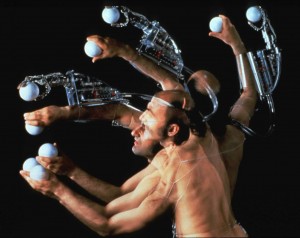
Post-humanism can loosely refer to the conscious continuation of the human species through the next stage of evolution; in which most post-humanists believe technology (either physical or virtual) will take an active role. While there are many different forms of post-humanism, from philosophical post-humanism which critically refutes the the foundational assumptions of Renaissance Humanism and its relationship of body to nature to trans-humanism; an ideology that actively seeks to make available post-human technologies that eliminate aging and have the potential of greatly increasing human cognitive and physical capabilities.
Katherine Hayles, posits that the positioning of oneself as a post-human and actively accepting this fact is in fact the beginning of post-humanism. In many ways we have already tampered with the body; extending our physical limitations as means of creating a much greater and enhanced ‘reach.’ This reach is a capability; and when in the context of the human body and its envelope, reach refers to what we are able to extend our presence upon and also what we perceive that limit to be. The physical body, for an example, with its nerve sensors and feedback input devices, as an organ in totality is an extension or prosthesis of the human cognition.
Tools, as extensions of the arm, have continuously evolved through an iterative design process to make up for our impedition of the human biological process. It began with simple stones to smash, cut, and create fire; tools that bagin to evolve into hammers, arrowheads, and knives. And these tools became replacements of what we once had; prosthetic limbs reoriented those who had lost or were born without limbs.
“Prosthetic technology alternated between producing substitutes for the body parts that military weapons had destroyed and producing these very weapons. All weapons are prosthetic. Like all prostheses, they are always mechanisms of both defence and attack.” -Mark Wigley
These extensions replace the ‘softness’ of our physical envelope and provide greater reach into our environment and making resources available to us. These objects now exist as virtual and physical extensions of our humanely presence on earth; we have connected ourself into vast networks of information exchange and data visualization. But post-humanism states this will go even further, as technologies that enhance our physical abilities and mental cognition, they will become integrated with the human envelope. In place of this futuristic condition, filling this milieu in the next stage of humanity is architecture.
“We all need means of supplementing our natural capabilities, since nature is indifferent, inhuman (extra-human), and inclement; we are born naked and with insufficient armor…The barrel of Diogenes, already a notable improvement on our natural protective organs (our skin and scalp), gave us the primordial cell of the house; filing cabinets and copy-letters make good the inadequacies of our memory; wardrobes and sideboards are the containers in which we put away the auxiliary limbs that guarantee us against cold or heat, hunger or thirst…Our concern is with the mechanical system that surrounds us, which is no more than an extension of our limbs; its elements, in fact, artificial limbs.” -Le Corbusier
Architecture acts as one of the many extensions of the human envelope, providing shelter from the atmosphere and generating a wide range of psycho-perceptive affects and experiences that act as extensions of the mind. The phantom limb that is architecture allows us to project what we desire or need from spaces that we cannot obtain ourselves. As does the phantom limb exert a sensation of virtually created pain, architecture creates the imaginary projections and feelings of inhabitation, dwelling, and affect.